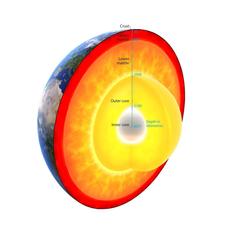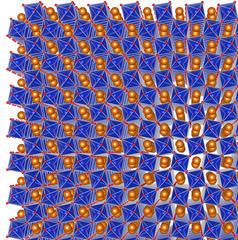URL: https://www.desy.de/news/news_search/index_eng.html
Breadcrumb Navigation
DESY News: Scientists probe Earth's deep mantle in the lab
News
News from the DESY research centre
Scientists probe Earth's deep mantle in the lab
Simulating the conditions 2700 kilometres deep underground, scientists have studied an important transformation of the most abundant mineral on Earth, bridgmanite. The results from the Extreme Conditions Beamline at DESY's X-ray light source PETRA III reveal how bridgmanite turns into a structure known as post-perovskite, a transformation that affects the dynamics of Earth's lower mantle, including the spreading of seismic waves. The analysis can provide an explanation for a range of peculiar seismic observations, as the team headed by Sébastien Merkel from the Université de Lille in France report in the Journal Nature Communications.

The crystal structures of bridgmanite (left) and post-perovskite (right). Credit: Université de Lille, Sébastien Merkel
The freshly made bridgmanite was then put under even higher pressure of 1.2 megabar (about 1.1 million times the pressure on the surface) corresponding to the lowest layer of Earth's mantle, just above the core. Here, seismic waves are reflected while they are travelling through Earth's interior, and the way they are reflected depends on the characteristics of the material they encounter. “Seismic waves sometimes behave funny in that region,” says Merkel. “Sometimes you see strong reflections, and sometimes you don't see anything at all.”
Scientists have long suspected that a structural change within bridgmanite is an important part of the explanation. „We have known for 15 years that bridgmanite transforms to a different crystal structure called post-perovskite under these conditions, but what we didn't know was, how fast it does that,” explains Merkel. Post-perovskite consists of the same chemical elements as bridgmanite, but has a different crystal structure, leading to different characteristics.

The inner structure of the Earth. The investigations simulated condition as in the lower mantle. Credit: DESY, Franziska Lorenz & Jochen Stuhrmann
The mantle-core boundary at about 2900 kilometres below the surface is not as sharp as a mirror surface. Instead in a region roughly 200 kilometres above the core, known as the D" layer, large slabs of different material with different structures move about. “You can think of it as a second set of plate tectonics down there,” explains Merkel. Also, in a boundary layer of about 100 kilometres thickness, bridgmanite and post-perovskite can co-exist, complicating the analysis of seismic signals. The more details scientists know about the physical characteristics of the material at the boundary, the better the analysis they can do. This helps not only to investigate the boundary region itself, but also many other regions inside the Earth, as seismic waves probe all layers on their way. “The better we know the material characteristics at the core-mantle boundary, the sharper is our view of the Earth's interior,” underlines Merkel.
The Université de Lille, the Université Clermont Auvergne, the University of Münster, the Université Lyon, the Institut Universitaire de France and DESY were involved in this work.
Reference:
Kinetics and detectability of the bridgmanite to post-perovskite transformation in the Earth’s D′′ layer; Christopher Langrand, Denis Andrault, Stéphanie Durand, Zuzana Konopková, Nadège Hilairet, Christine Thomas, and Sébastien Merkel; Nature Communications, 2019; DOI: 10.1038/s41467-019-13482-x




